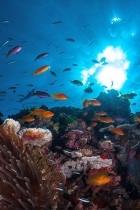Dory and Nemo Alive and Well on Australia’s Great Barrier Reef

Despite recent media reports about the ‘death’ of large swathes of Australia’s Great Barrier Reef, experts say the recent major coral bleaching event was restricted to one section of the Reef and much of that may replenish.
Jo Howard, Director at Ocean Alliance said surveys and sampling by local agencies responsible for monitoring Reef health for more than 40 years show the majority of the coral on the Reef has survived, with three quarters of the Great Barrier Reef in good health and flourishing.
“The Great Barrier Reef, one of the world’s most diverse natural habitats, stretches for over 348,000kms² - which is larger than Italy,” he said. “The Great Barrier Reef Marine Park Authority (GBRMPA) and the Australian Institute of Marine Science (AIMS) have released preliminary findings that indicate only the northern tip of the Reef has been impacted by the bleaching episode.”
GBRMPA Chairman, Dr Russell Reichelt, said the mortality assessment was based on hundreds of comprehensive in-water surveys conducted Reef-wide with AIMS, the Queensland Parks and Wildlife Service and other partners since the beginning of March 2016.
 Image credit CSIRO
Image credit CSIRODr Reichelt said they are now working together to develop a comprehensive and authoritative picture of how this year’s bleaching has impacted the ecosystem as a whole.
“We’ve opted to release results ahead of final completion of surveys because of widespread misinterpretation of how much of the Reef has died,” said Dr Reichelt.
“Fortunately, the section of the Marine Park that’s had substantial increase in coral cover in recent years —the southern part of the Reef — has experienced little mortality,” he stated. “We know the Great Barrier Reef is still resilient with the ability to recover from major events, given enough time.”
AIMS Chief Executive John Gunn states that this serious bleaching event was related to a combination of warming of our planet’s oceans and a major El Niño.
“We know many corals in the northern sector will die, but many others will recover from bleaching over the coming months and we’re hopeful that in areas where bleaching has been minor the Reef will bounce back well.”

The reef has regenerated after past bleaching episodes
“This underlying resilience was on display recently when the Australian Institute of Marine Science found coral cover increased by 19 percent across the Marine Park between 2012 and 2015, nearly doubling in the southern sector due to good early recovery.”
Mr Howard reported that at the 2016 ASMEX conference in May, delegates were assured that bleaching was in no way caused by visiting superyachts or charter vessels. Simon Banks, GBRMPA general manager said coral bleaching and damage can be attributed to warmer than usual sea temperatures and in some cases, silting from onshore activity.
“Our industry, scientific and regulatory bodies and governments are united in preserving the health of the Great Barrier Reef. The Great Barrier Reef continues to be one of the natural wonders of the world, with hundreds of islands and coral reefs to explore and unique marine life to experience,” said Mr Howard.
“Charter clients should not be concerned by the recent misinterpretation of the extent of the coral bleaching. The Great Barrier Reef still offers an incredible charter experience with many areas untouched by the bleaching event.”

Great Barrier Reef – Stats & Facts
What causes bleaching?
Bleaching occurs when live corals are stressed, in this case from overheating. If the waters cool down quickly enough, the corals can survive, but if the corals remain stressed for many weeks, they can die off. According to the Bureau of Meteorology, the Reef recorded its highest average sea surface temperatures for February, March and April since records began in 1900.
Are all bleached corals dead?
Bleached white corals are not dead. These corals are under stress from unusually hot conditions. If the heat stress does not persist for too long, the corals can recover and regain their colour.
What is the prognosis for recovery?
The Great Barrier Reef is large and resilient with the ability to recover from major events.
Recovery from the current bleaching event will largely depend on how long ocean temperatures remain high locally. If conditions return to normal, the tiny algae that give corals their food and colour can repopulate corals. However, if ocean temperatures are too high for too long, the corals will eventually starve and die.
On the most resilient reefs and in ideal circumstances, bleached corals can regain their colour within a period of weeks to months once water temperatures return to normal.
What does bleaching mean for visitors?
Covering 348,000km², the Reef contains many places where visitors can experience and enjoy the marine environment. In the short to medium term, there will be minimal effect on fish and invertebrates and other diverse reef organisms. There are also many experiences on offer throughout the Marine Park, from hiking and bird watching on islands, kayaking, swimming and other aquatic activities.
(Source: Australian Institute of Marine Science)
M/Y SOVEREIGN n the Great Barrier Reef
Jo Howard states: “Our industry, scientific and regulatory bodies and governments are united in preserving the health of the Great Barrier Reef. The Great Barrier Reef continues to be one of the natural wonders of the world, with hundreds of islands and coral reefs to explore and unique marine life to experience.
“Charter clients should not be concerned by the recent misinterpretation of the extent of the coral bleaching. The Great Barrier Reef still offers an incredible charter experience with many areas untouched by the bleaching event.”
For more information visit www.oceanalliance.com.au
*All images courtesy of Ocean Alliance


Post your comment
You cannot post comments until you have logged in.
Login to post a commentComments
No one has commented on this page yet.
RSS feed for comments on this page | RSS feed for all comments